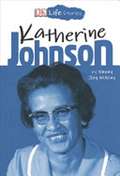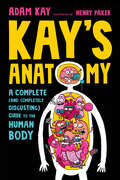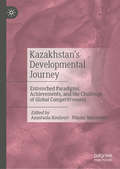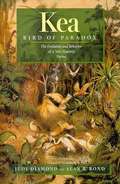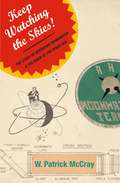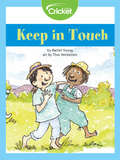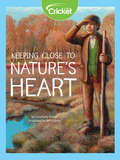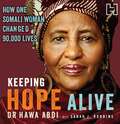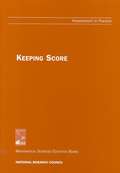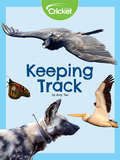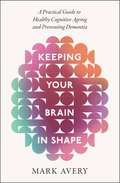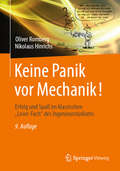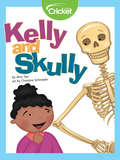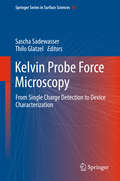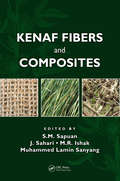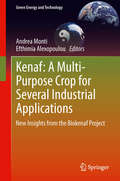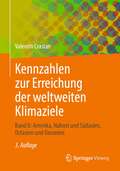- Table View
- List View
Katherine Johnson (DK Life Stories)
by Ebony Joy Wilkins Charlotte AgerIn this kids' biography, discover the inspiring story of Katherine Johnson, famed NASA mathematician and one of the subjects of the best-selling book and movie Hidden Figures. <p><p> It was an incredible accomplishment when the United States first put a person on the moon--but without the incredible behind-the-scenes work of NASA mathematician Katherine Johnson, such a feat could not have been possible. In this biography for kids ages 8-12, follow Katherine's remarkable journey from growing up in West Virginia, to becoming a teacher, to breaking barriers at NASA and receiving the Presidential Medal of Freedom in 2015. <p> DK Life Stories go beyond the basic facts to tell the true life stories of history's most interesting people. Full-color photographs and hand-drawn illustrations complement thoughtfully written, age-appropriate text to create an engaging book children will enjoy reading. Definition boxes, information sidebars, fun facts, maps, inspiring quotes, and other nonfiction text features add depth, and a handy reference section at the back makes this series perfect for school reports and projects. Each book also includes an author's introduction letter, a glossary, and an index.
Kaufman Field Guide to Nature of New England
by Kenn Kaufman Kimberly KaufmanWhether you're walking in the woods or along the beach, camping, hiking, canoeing, or just enjoying your own backyard, this book will help identify all your nature discoveries. With authoritative and broad coverage, using nontechnical and lively language, this guide is an essential reference for nature lovers living in or visiting New England.
Kay's Anatomy: A Complete (and Completely Disgusting) Guide to the Human Body
by Adam KayThis complete (and completely gross) guide to the human body is the hilarious debut nonfiction children's book from world-wide multi-million bestselling author and former doctor Adam Kay! Do you ever think about your body and how it works? Like really, really think about it? The human body is extraordinary and fascinating and, well...pretty weird. Yours is weird, mine is weird, your math teacher's is even weirder. This book is going to tell you what's actually going on in there, and answer the really important questions, like:Are boogers safe to eat? Look, if your nose is going to all that effort of creating a snack, the least we can do is check out its nutritional value. (Yes, they're safe. Chew away!)And how much of your life will you spend on the toilet? About a year—so bring a good book. (I recommend this one.) Sit back, relax, put on some rubber gloves, and let a doctor take you on (slightly repulsive) tour of your insides. Welcome to Kay's Anatomy*. *A fancy word for your body. See, you're learning already.
Kazakhstan’s Developmental Journey: Entrenched Paradigms, Achievements, and the Challenge of Global Competitiveness
by Nikolai Mouraviev Anastasia KoulouriThis book discusses Kazakhstan’s transitioning trajectory to a market economy since it declared its independence from the Soviet Union in 1991.. It analyses the evolution of key policy areas and sectors through the lens of policy development and implementation, and evaluates their suitability in pursuing the country’s strategic objectives. Topics include policy initiatives for economic development, new policy paradigms in public service delivery and infrastructure improvement, and water-energy-food (WEF) nexus thinking in governing the WEF sectors. The book argues that policies developed in the 1990s and 2000s have so far served the nation’s needs. Nevertheless, as Kazakhstan seeks to achieve a competitive edge worldwide, many of these policies would require adjustment, or a paradigm shift. Providing a unique outlook on policy and governance, this book will appeal to scholars, students, and practitioners involved with Kazakhstan and Central Asia and interested in the transformation of ex-Soviet nations, their policy, and sustainable development.
Kea, Bird of Paradox: The Evolution and Behavior of a New Zealand Parrot
by Judy Diamond Alan B. BondThe kea, a crow-sized parrot that lives in the rugged mountains of New Zealand, is considered by some a playful comic and by others a vicious killer. Its true character is a mystery that biologists have debated for more than a century.
Keep It Real (From the Files of Madison Finn #19)
by Laura DowerMadison is tired of all the secrets--why can't everyone just keep it real?Madison's not sure if her imagination is working overtime. Everyone--including her mom--is acting different! When Maddie checks out a new feature on TweenBlurt.com, she finds out her keypal, Bigwheels, has been keeping things from her. And then Hart sends a mean email about Madison--is he keeping secrets too?The truth is not always obvious, and Maddie isn't sure how to get the answers she wants. When her mom tells her a secret about Poison Ivy's family, Maddie knows it's serious news, and she's tempted to share it--especially when Ivy is acting mean. But some information is not ours to share . . .
Keep Out of Reach of Children
by Mark A. Largent"Well-researched. . . . A revealing work. " - Kirkus Reviews "A fascinating history of a public health crisis. Compellingly written and insightful, Keep Out of Reach of Children traces the discovery of Reye's syndrome, research into its causes, industry's efforts to avoid warning labels on one suspected cause, aspirin, and the feared disease's sudden disappearance. Largent's empathy is with the myriad children and parents harmed by the disease, while he challenges the triumphalist view that labeling solved the crisis. " - ERIK M. CONWAY , coauthor of Merchants of Doubt "Largent's engaging and honest account explores how medical mysteries are shaped by prevailing narratives about venal drug companies, heroic investigators, and Johnny-come-lately politicians. " - HELEN EPSTEIN , author of The Invisible Cure Reye's syndrome, identified in 1963, was a debilitating, rare condition that typically afflicted healthy children just emerging from the flu or other minor illnesses. It began with vomiting, followed by confusion, coma, and in 50 percent of all cases, death. Survivors were often left with permanent liver or brain damage. Desperate, terrorized parents and doctors pursued dramatic, often ineffectual treatments. For over fifteen years, many inconclusive theories were posited as to its causes. The Centers for Disease Control dispatched its Epidemic Intelligence Service to investigate, culminating in a study that suggested a link to aspirin. Congress held hearings at which parents, researchers, and pharmaceutical executives testified. The result was a warning to parents and doctors to avoid pediatric use of aspirin, leading to the widespread substitution of alternative fever and pain reducers. But before a true cause was definitively established, Reye's syndrome simply vanished. A harrowing medical mystery, Keep Out of Reach of Children is the first and only book to chart the history of Reye's syndrome and reveal the confluence of scientific and social forces that determined the public health policy response, for better or for ill. Mark A. Largent , a survivor of Reye's syndrome, is the author of Vaccine: The Debate in Modern America and Breeding Contempt: The History of Coerced Sterilization in the United States. He is a historian of science, Associate Professor in James Madison College at Michigan State University, and Associate Dean in Lyman Briggs College at Michigan State University. He lives in Lansing, Michigan.
Keep Watching the Skies!: The Story of Operation Moonwatch and the Dawn of the Space Age
by W. Patrick McCrayWhen the Soviets launched Sputnik in 1957, thousands of ordinary people across the globe seized the opportunity to participate in the start of the Space Age. Known as the "Moonwatchers," these largely forgotten citizen-scientists helped professional astronomers by providing critical and otherwise unavailable information about the first satellites. In Keep Watching the Skies!, Patrick McCray tells the story of this network of pioneers who, fueled by civic pride and exhilarated by space exploration, took part in the twentieth century's biggest scientific endeavor. Around the world, thousands of teenagers, homemakers, teachers, amateur astronomers, and other citizens joined Moonwatch teams. Despite their diverse backgrounds and nationalities, they shared a remarkable faith in the transformative power of science--a faith inspired by the Cold War culture in which they lived. Against the backdrop of the space race and technological advancement, ordinary people developed an unprecedented desire to contribute to scientific knowledge and to investigate their place in the cosmos. Using homemade telescopes and other gadgets, Moonwatchers witnessed firsthand the astonishing beginning of the Space Age. In the process, these amateur scientists organized themselves into a worldwide network of satellite spotters that still exists today. Drawing on previously unexamined letters, photos, scrapbooks, and interviews, Keep Watching the Skies! recreates a pivotal event from a perspective never before examined--that of ordinary people who leaped at a chance to take part in the excitement of space exploration.
Keep in Touch
by Rachel YoungOne of our five senses is touch. The sense of touch can help us learn about the world and our surroundings. Test out your sense of touch with these easy experiments.
Keeping Close to Nature's Heart
by Carollyne HutterEvery visitor of Yosemite National Park in California should say "thank you" to one man: John Muir.
Keeping Hope Alive: How One Somali Woman Changed 90,000 Lives
by Dr. Hawa AbdiFor the last twenty years, Dr Hawa Abdi and her daughters have run a refugee camp on their family farm not far from Mogadishu which has grown to shelter 90,000 displaced Somalis: men, women, and children in urgent need of medical attention. As Islamist militia groups have been battling for control of the country creating one of the most dire human rights crises in the world, Dr. Abdi's camp is a beacon of hope for the Somalis, most of whom have no proper access to health care. She was recently held hostage by a militant groups who threatened her life and told her that because she's a woman she has no right to run the camp. She refused to leave.This is not just the story of a woman doctor in a war torn Islamic country risking her life daily to minister to thousands of desperate people, it's also an inspiring story of a divorced woman and her two daughters, bound together on a mission to rehabilitate a country.
Keeping Score: Assessment in Practice
by Ann ShannonKeeping Score is a brief and well organized consideration of effective authentic assessment.-- Teacher Education Materials Project online
Keeping Things Whole: Readings in Environmental Science
by Joseph Coulson Donald Whitfield Ashley L. PrestonWholeness is the key theme of this anthology on the environment. We are one with the natural world, not just with the millions of other living species with whom we share it but also with the elements of air, water, and earth of which we are composed. Sometimes we need to stand back and view our world in perspective from the beginnings of the universe to the littleness of our affairs.
Keeping Track
by Amy TaoDid you know that scientists can track animals? By tracking animals, scientists can see where animals migrate to and from. These trackers can be big or small and are different depending on the kind of animal being tracked. Learn about the different technology that is used for tracking!
Keeping Watch: A History Of American Time
by Michael O'MalleyA history of the transition from natural to mechanical sources for time, Keeping Watch explores the invention of Standard Time Zones and daylight saving as well as the mass production of watches and clocks.
Keeping Your Brain in Shape: A Practical Guide to Healthy Cognitive Ageing and Preventing Dementia
by Mark AveryAre you worried about signs of dementia in yourself or a loved one? How can you tell what is abnormal cognitive decline and what is a typical feature of getting older? What steps can you take to keep your brain in shape for longer?The good news is that there is a lot of detailed and rigorous scientific research to answer these questions. The bad news is that there is so much of this that it is a daunting and bewildering process to make sense of it. You would soon become lost in a complex world of scholarly articles where the findings can appear contradictory and hard to fathom. How can you deduce what practical steps you might need to actually take?Mark Avery's comprehensive and easily-readable guide is here to help you navigate a pathway through the maze of literature on cognitive ageing. You will find here chapters on hearing loss, sleep, social networks, physical activity, grief, drinking and breathing. The book also deals with the importance of living in the present − coping with technological change and remaining curious about the world around you.This book provides you with an action plan for what positive steps you can take to keep your brain healthy and in good working order for as long as possible and includes:· An introduction to understanding how to interpret the science· A glossary of terms associated with cognitive ageing· A unique approach to easily navigating the book in whichever way you choose· Helpful summaries with clear action points
Keine Panik vor Mechanik!: Erfolg und Spaß im klassischen "Loser-Fach" des Ingenieurstudiums
by Oliver Romberg Nikolaus HinrichsDer Begleiter durch das klassische "Loserfach" im Ingenieurstudium. Inhalt des Buches sind die Grundlagen der Mechanik, wie sie im ingenieurwissenschaftlichen Grundstudium behandelt werden, also Statik, Festigkeitslehre, Kinematik und Kinetik, in unkonventioneller, humorvoller Darstellung mit 300 Cartoons und Zeichnungen sowie 99 Übungsaufgaben mit ausführlichen Lösungen. Nach dem Motto: "Schluss mit dem Prüfungsdurchfall!" bleibt trotz der lockeren Darstellungsweise die Korrektheit des Inhalts nicht auf der Strecke.
Kelly and Skully
by Amy TaoKelly's grandmother is a doctor who has a scary-looking skeleton named Skully in her office. One day, Skully comes to life and explains to Kelly all the important things a skeleton does. Suddenly, Skully isn't so scary anymore.
Kelvin Probe Force Microscopy: Measuring And Compensating Electrostatic Forces (Springer Series in Surface Sciences #48)
by Sascha Sadewasser Thilo GlatzelThis book provides a comprehensive introduction to the methods and variety of Kelvin probe force microscopy, including technical details. It also offers an overview of the recent developments and numerous applications, ranging from semiconductor materials, nanostructures and devices to sub-molecular and atomic scale electrostatics.In the last 25 years, Kelvin probe force microscopy has developed from a specialized technique applied by a few scanning probe microscopy experts into a tool used by numerous research and development groups around the globe. This sequel to the editors’ previous volume “Kelvin Probe Force Microscopy: Measuring and Compensating Electrostatic Forces,” presents new and complementary topics.It is intended for a broad readership, from undergraduate students to lab technicians and scanning probe microscopy experts who are new to the field.
Kenaf Fibers and Composites
by Muhammed Lamin Sanyang S. M. Sapuan J. Sahari M. R. IshakKenaf fiber is gaining attention as an alternative reinforcement for composite products due to low cost, reduced environmental impact, and attractive mechanical properties. Kenaf Fibers and Composites covers the breadth of these exciting materials, from raw material preparation to application in a variety of products. It discusses fiber characterization and properties, how to prepare kenaf-based composites, and design, manufacturing, and applications. It also covers hybrid fiber composites, kenaf fiber thermosetting composites, kenaf fiber thermoplastic composites, kenaf fibers in various lengths, and forms and arrangements such as particulates, continuous roving, and woven fabrics. Cellulose-based kenaf composites and kenaf fiber-filled biopolymer composites are presented.
Kenaf: A Multi-Purpose Crop for Several Industrial Applications
by Andrea Monti Efthimia AlexopoulouNatural plant fibers fibres are being increasingly used in manufacturing industrial products because of their renewable and biodegradable natures. Kenaf is an annual bast fibre crop that can provide fibres for several industrial applications (composites, insulation mats, absorbents, bedding material, etc.) as well as raw material for energy exploitation (solid biofuels). Kenaf: A Multi-Purpose Crop for Several Industrial Applications introduces the physiology and field management of kenaf, agronomy, productivity, harvesting as well as its the industrial and energy uses of this promising non-food crop. Including recent research collected by the BIOKENAF project, Kenaf: A Multi-Purpose Crop for Several Industrial Applications provides a global picture of state of the art research and developments with Kenaf from Asia, USA and Australia. This thorough introduction if followed up with an assessment of the crops economic viability as well as an the environmental impact assessment of kenaf. Although not a new crop, Kenaf: A Multi-Purpose Crop for Several Industrial Applications provides a comprehensive introduction to this crop and its developing applications for energy engineers, industry managers, politicians and managers working to develop sustainable energy sources and bio-economies.
Kennzahlen zur Erreichung der weltweiten Klimaziele: Band II: Amerika, Nahost und Südasien, Ostasien und Ozeanien
by Valentin CrastanAnalysiert werden die aktuellen Kennzahlen aus der Energiewirtschaft für die geographischen Einheiten Amerika – unterteilt in Nordamerika (Kanada + USA) sowie Mittel- und Südamerika –, Nahost und Südasien sowie Ostasien und Ozeanien. Die wichtigsten energiewirtschaftlichen Indikatoren der einzelnen Regionen und Länder und deren Entwicklung werden in zahlreichen Grafiken und Energieflussdiagrammen veranschaulicht. Darauf basierend empfiehlt der Autor eine Verteilung der zur Begrenzung des Klimawandels notwendigen Emissionsreduktion (für Klimaziel 2 °C und 1,5 °C, mit Perspektive bis 2050).Die in diesem Band behandelten Erdteile verursachen zusammen 77 % der Emissionen. Europa + Eurasien sowie Afrika werden in einem weiteren Band behandelt.
